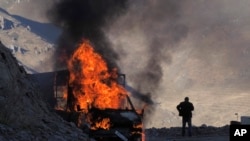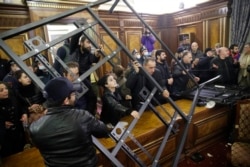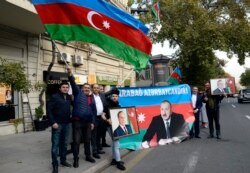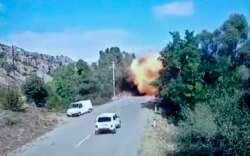On November 10, the 2020 Nagorno-Karabakh war came to an apparent end after six weeks of fighting. A Russian-brokered peace deal between Armenia and Azerbaijan halted the hostilities.
The mountainous, Armenian-majority enclave within Azerbaijan has been bitterly contested since the late Soviet period, with a 1988–1994 war claiming tens of thousands of lives. That war resulted in de facto Armenian control of the territory, leading to sporadic fighting over the ensuing decades.
A Turkish-backed Azerbaijani offensive kicked off on September 27 following border clashes in July. After a series of critical Azerbaijani military advances, including the seizure of the city of Susha, Armenian Prime Minister Nikol Pashinyan was compelled to accept peace terms he described as “unbelievably painful” for him and the Armenian people.
The peace deal, under which Azerbaijan will maintain control of areas its seized during the war, was met with impassioned protests in Armenia calling for Pashinyan to step down.
Azerbaijani President Ilham Aliyev, in turn, released a triumphant statement which he described as having “historical significance.”
Stating that Pashinyan had been forced to capitulate in a “cowardly and treacherous manner … under pressure from the iron fist,” Aliyev broadly justified his own forces’ actions while condemning those of the opposition.
He accused Armenia of committing war crimes, among them using ballistic missiles against civilians in the Azerbaijani city of Ganja, as well as targeting the city of Barda with cluster munitions.
“[Our soldiers] have crushed the enemy and were perfectly right to do that because they are on their own land,” Aliyev said. “We abide by international law. We respect international law. We did not take revenge on civilians, we will never take revenge on civilians. In fact, this is why there are very few civilian casualties on the enemy side.”
That statement is misleading.
In fact, Armenia and Azerbaijan have both been credibly accused of violating international humanitarian law.
On October 28, two days after a U.S.-brokered ceasefire, the two sides accused each other of targeting civilians. Azerbaijan’s Defense Ministry said 21 civilians had been killed and 70 injured in rocket attacks on the city of Barda, located in central Azerbaijan outside the Nagorno-Karabakh region, Radio Free Europe/Radio Liberty reported.
The Armenian Defense Ministry accused Azerbaijani forces of shelling a hospital and maternity clinic in Stepanakert, Nagorno-Karabakh’s de facto capital. That attack reportedly resulted in no casualties, while a separate rocket attack on the nearby town of Shushi (Susa) killed two.
While Armenia and Azerbaijan denied targeting civilians, the International Committee of the Red Cross reported it had “witnessed intense shelling in urban areas on both sides of the front line [on October 28], leading to death, destruction, injuries and desolation.”
Earlier in October, three BBC journalists were injured inside of the Holy Savior Cathedral in Susha after documenting destruction there the previous day. Armenia's Defense Ministry accused Azerbaijan of deliberately targeting the cathedral, with locals saying nothing of strategic or military importance was located there.
Armenian authorities have accused Azerbaijan of systematically targeting religious and cultural sites, in violation of international law.
On November 2, the United Nations High Commissioner for Human Rights (UNHCR) Michelle Bachelet warned that indiscriminate attacks in populated areas might be war crimes.
“International humanitarian law cannot be clearer. Attacks carried out in violation of the principle of distinction or the principle of proportionality may amount to war crimes, and the parties to the conflict are obliged to effectively, promptly, thoroughly and impartially investigate such violations and to prosecute those alleged to have committed them,” Bachelet said.
Although both sides have made misleading claims on social media, the UNHCR expressed concern over footage allegedly documenting a war crime committed by Azerbaijan forces.
On October 15, two videos shared on Azerbaijani Telegram channels appeared to show Azerbaijani soldiers executing two Armenians in military uniforms — Benik Hakobyan, 73, and Yuri Adamyan, 25. Media and investigative websites believe the footage is genuine.
The UNHCR noted that “the wilful [sic] killing of protected persons constitutes a grave breach of the Geneva Conventions and therefore constitutes a war crime.”
BBC journalist Orla Guerin told Aliyev during an interview that her colleagues had witnessed “indiscriminate shelling” of Stepanakert by Azerbaijani forces “without clear military targets” from October 1-3. In those attacks, an emergency services center was targeted and an apartment block destroyed.
Aliyev dismissed her account as “fake news.”
Guerin also noted evidence that cluster munitions was used by Azerbaijani forces in civilian areas.
On October 23, New York-based Human Rights Watch released a report saying Azerbaijan had “repeatedly used widely banned cluster munitions in residential areas in Nagorno-Karabakh.”
The group documented four such incidents during an on-site investigation that month.
“The continued use of cluster munitions – particularly in populated areas – shows flagrant disregard for the safety of civilians,” said Stephen Goose, arms division director at Human Rights Watch and chair of the Cluster Munition Coalition.
“Cluster munitions should never be used by anyone under any circumstances, much less in cities, due to the foreseeable and unacceptable harm to civilians.”
The UNHCR noted troubling reports that both sides had used cluster munitions, adding that the use of such weapons in civilian areas is “incompatible with the international humanitarian law principles governing the conduct of hostilities.”
Likewise, Amnesty International reported that evidence examined by its Crisis Response team “strongly” suggested that the use of ballistic missiles and inaccurate rocket artillery salvos from Armenia and Azerbaijan had caused civilian deaths and widespread damage, “in apparent violation of international humanitarian law.”
Amnesty also reported civilian casualties and severe damage to civilian buildings in Ganja, Azerbaijan, as a result of repeated “artillery shelling from the Armenian side.”








